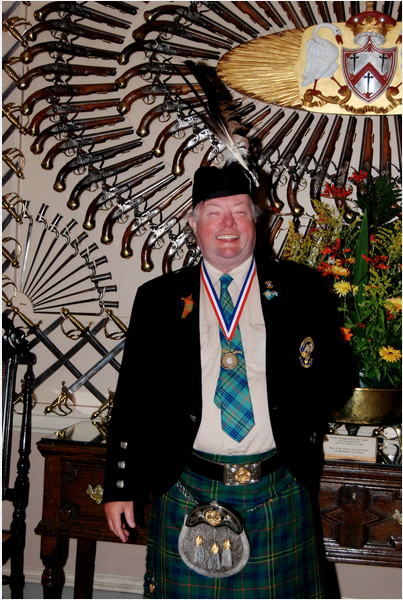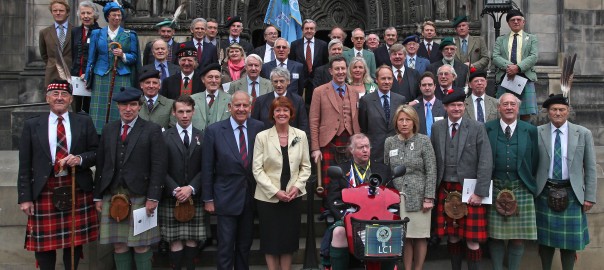By Sir Malcolm MacGregor, Convenor
This week is the 200th anniversary of the battle of Waterloo, Belgium. Without going into detail, the outcome of the battle, likeTrafalgar, shaped Europe until World War 1. Hundreds of clansmen from the Outer Hebrides to the borders fought at Waterloo. There are many epic tales involving the Guards, the Royal Scots Greys, the Highland and lowland Brigades. War artists, such as Lady Butler, came to prominence as well. Lady Butler’s painting of the charge of the Greys entitled ‘Scotland forever’ is perhaps the most well known. Sgt Ewart of the Greys, who captured the French Eagle, was feted around Edinburgh and the borders by Sir Walter Scott.
Frank Wherrett, SCSC secretary, has carried out extensive research into the clan component of the Duke’s Army, painstakingly going through the nominal role of all those who were awarded the Waterloo Medal – some 24,000 names. The list is topped by Clan Donald and Campbell at 175 and 150 respectively. Clan Gregor is on 35. Nearly every clan & family name is represented, – highland, lowland and Borderers. 19% of the Duke’s Army were Scots, from a population of 10% of UK. The Duke of Wellington himself was of course Irish.
Wellington’s chief medical officer was Sir Charles McGrigor who created the system of casualty evacuation as a formal logistical operation of war, perfected in the Peninsular Campaign. He founded the Royal Army Medical Corps. Sergeant Macgregor was one of a band of 5 Scots/irish soldiers and 5 english officers who successfully closed the gates at Hougoumont Farm against a full French onslaught, and thus turned the whole battle. Sous-Lieutenant LeGros ( that really was his name) and known as ‘L’enforceur’, to friend and foe, was a 6ft 6in beast of a man from the Imperial Guard, tasked by Napoleon to break into the farm, by smashing down the gates with an axe. Incredibly, he succeeded but he and his imperial guards were overpowered. Colonel Macdonnell (brother of the Glengarry chief) commanded the Coldstream Guards and 3rd Foot Guards (later Scots Guards) at Hougoumont. He was also part of the gate group and was effectively named ‘man of the match’ by the Great Duke. He shared the accolade of being ‘the bravest man in Britain’ with Corporal James Graham who was Scots/Irish.
Meanwhile Piper Kenneth Mackay, from Reay in Caithness, and of the Cameron Highlanders played the tune “Peace or War”, marching round the outside of the square formed by the Camerons in defence against the French massed cavalry charge led by the heroic Marshal Ney, when ‘the earth vibrated under the thundering tramp of the mounted host’. Mackay was later given a set of silver mounted bagpipes by the King in Paris.
My role in the commemoration is to represent the SCSC and the clans/families at the ceremony at Hougoumont Farm, of the unveiling of the Monument dedicated to the British Army that fought at Waterloo. The ceremony will be enriched by a Guard of Honour from the Scots Guards and the pipes and drums in full rig. So there will be a good number of kilts present. The planning of the event has mainly been carried out by the Guards Division and the British Embassy in Brussels. They have done an extraordinary job in tracking the descendants of key figures in the German, Belgian and Dutch contingents of the Duke’s army. Family names that became well known in later years such as Kielmansegg and Stauffenberg. Something of a relief to know that the Army and our Foreign Office have stepped up to the plate on this.
In order to keep the French under control, as they think they won the battle, or that it was at least a draw, there is to be a brief ceremony at the monument involving the Duke of Wellington, Prince Nikolas Blucher and Prince Charles Bonaparte.
There are other events taking place in Scotland in Edinburgh, the borders and Drumlanrig Castle, which are being covered by the bold Lady MacGregor and Border TV. Additionally there is a commemorative service at St. Paul’s Cathedral, London. The SCSC will be represented by the Hon. Katherine Nicolson whose ancestor, Lord Saltoun, chief of the Frasers, commanded the 1st Foot Guards at Waterloo. The final crushing blow at the battle was the rout of Napoleon’s Imperial Grenadier Guard by the 1st Guards from which they later took the name Grenadier Guards. The bearskin cap, worn by the Imperial Guard, was subsequently adopted by the Guards Brigade as a result, and is still worn today on ceremonial duties.
A final point of interest from a diaspora perspective. Most of the accommodation around Brussels is fully booked up not by the British, but by americans and canadians who are descendants of those who fought in the Duke’s Army. Indeed there is an american arm of the Hougoumont restoration project team.
I look forward to meeting Lord Uxbridge with or without his ancestor’s leg.



